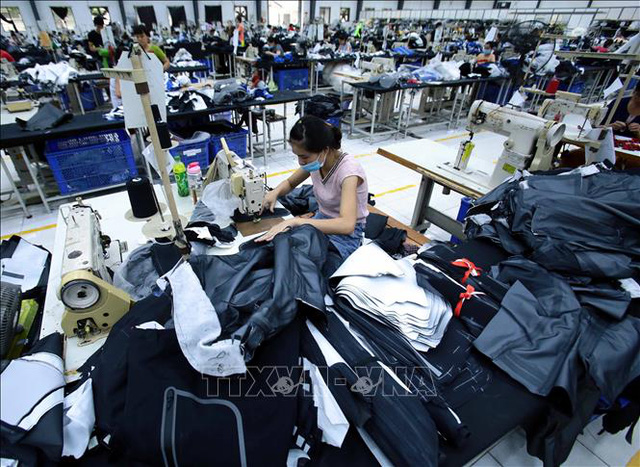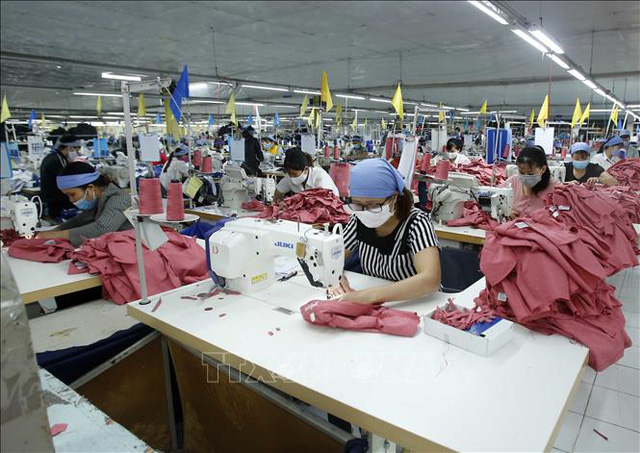Although businesses have implemented solutions to maintain production and business, it is forecasted that this year's textile export turnover will decline sharply compared to 2019, "reaching the maximum" target of about 34 billion USD.

Garment processing for export clothes at Kydo Vietnam Garment Co., Ltd. in Pho Noi A Industrial Park (Hung Yen). Photo: Pham Kien / VNA
"Thirst" orders
Since the outbreak of COVID-19, the supply chains in the textile and garment industry have been broken, and the circulation of goods has stalled. Every year, this time, the orders have been delivered to the production companies for the end of the year and even the first half of next year.
However, the epidemic caused the shortage of orders for businesses at the beginning of the year, even receiving orders every month, every week.
According to Mr. Than Duc Viet, General Director of Garment Corporation 10, since the COVID-19 epidemic happened, businesses all struggled with input materials, and had to solve the output problem to ensure the company and employee income. From March to now, the major orders of May 10 have declined sharply, typically from the US and Europe markets. Notably, orders for the main items of May 10 in recent years such as veston, shirt, trousers and office fashion products have been sharply reduced, from 40-60% ...
"Usually, orders are received 3-6 months in advance, but with the current situation, almost every month for textile orders", said Mr. Than Duc Viet.
Also according to Mr. Phi Ngoc Thinh, General Director of May Ho Guom, currently, European visitors are 3 months late, US visitors even answer when they have money to pay. Even so, Ho Guom May still receive the goods and if necessary, the company borrows money from a bank to pay workers' salaries.
“Now businesses have to live with floods. We accept reduced processing costs, not thinking about profits. Accept transient customer options, for example receiving raw materials, pre-production, stockpiling for 2021 for basic items, not fashion items, or uniform items, etc. ", Mr. Thinh said,
Theo thống kê của Bộ Công Thương, kim ngạch xuất khẩu hàng dệt và may mặc 8 tháng qua ước đạt 19,25 tỷ USD, giảm 11,6%; vải mảnh, vải kỹ thuật khác ước đạt 260 triệu USD, giảm 36,8%; xơ, sợi dệt các loại ước đạt 2,2 tỷ USD, giảm 19,4% so với cùng kỳ năm 2019.
Bộ Công Thương cũng cho biết, hiện chỉ có một số doanh nghiệp nhận được khoảng 50-60% đơn hàng cho tháng 9, đơn hàng các tháng còn lại của năm 2020 và năm 2021 đều chưa có thông tin rõ ràng.
Nhận định về kết quả của ngành dệt may trong năm 2020, Chủ tịch Hiệp hội Dệt may Việt Nam (Vitas) Vũ Đức Giang cho rằng, kim ngạch xuất khẩu ngành dệt may năm 2020 có thể đạt được cao nhất khoảng 34 tỷ USD, trong khi mục tiêu đặt ra là 40-42 tỷ USD. Nguyên nhân là do dịch COVID-19 đã khiến văn hóa tiêu dùng của người dân thay đổi, chuyển sang chi tiêu cho những sản phẩm thiết yếu chứ không đặt nặng vấn đề mua sắm như trước. Điều này đã dẫn đến sức mua toàn cầu giảm mạnh.
Theo dự báo của các chuyên gia ngành dệt may, năm nay, kịch bản khả quan là xuất khẩu dệt may vào khoảng 32 -33 tỷ USD, giảm khoảng 16% so với năm 2019. Việc tổng cầu giảm sẽ đẩy cuộc cạnh tranh giữa các quốc gia sản xuất dệt may trở nên khốc liệt hơn. Với tình hình thị trường suy giảm sâu, bất định và khó dự đoán, đơn hàng cho Quý IV hầu như chưa có sẽ là một thách thức vô cùng lớn cho kế hoạch kinh doanh của các doanh nghiệp.
Gỡ khó cho dệt may

Manufacturing garment products at Tien Hung Garment Joint Stock Company (Tien Lu District). Photo: Pham Kien / VNA
With difficulties caused by epidemics, socially isolated activities and consumption needs of global people have changed, more conservative in spending.
Many opinions said that from now to the end of the year, textile enterprises need to compensate for the shortage of export orders by promoting exploitation of the domestic market; At the same time, minimizing the decline in revenue and profitability by managing production costs, maintaining product quality, rearranging production forces, identifying the main workforce to maintain employment. and income for employees to accompany enterprises to overcome the difficult period when the market has not yet recovered.
According to Mr. Le Tien Truong, General Director of Vietnam National Textile and Garment Group (Vinatex), the coming time will continue to be a time of fierce fire testing for businesses. If passed, the business will have the opportunity to continue to recover and develop; At the same time it is also an affirmation of the capacity of existing businesses.
“The domestic market also needs to be given due attention; in which it must encourage the spirit of Vietnamese people to give priority to using Vietnamese goods. Along with that, continue to propose to the Government for exemption from social insurance, trade union fees in 2020, credit support policies at banks, such as: Delaying, postponing the payable of enterprises ", Mr. School said.
Also according to Mr. Phi Ngoc Thinh, General Director of May Ho Guom, banks should reduce interest rates, the state allows businesses to delay paying social insurance, health care, unemployment until the end of 2020, reduce electricity bills, land rent factory,…
Referring to solutions to overcome difficulties for enterprises, General Director of Nam Dinh Textile and Garment Joint Stock Corporation, Mr. Nguyen Van Mieng said that this unit has made changes in production structure, expanding domestic market. geography. Specifically, the company will take advantage of dyed fabrics to sell finished products and supply them to garment companies. At the same time, improve the chain-weaving-dyeing link so that all units in the chain can both stabilize and develop.
“In general, the yarn, fabric and dyed products of Nam Dinh Textile and Garment Joint Stock Corporation from now to the end of the year are expected to grow, possibly coming very close to the planned plan, although We are suffering losses in the first 6 months of the year, ”Mr. Mieng said.
In the current context, Mr. Vu Duc Giang recommends that textile enterprises promote the rapid conversion of the traditional product structure to fast adaptive items, for example when having difficulty in ordering with veston high-class, high-end shirts ... then switch to workwear, knitting knitwear, traditional shirts ...
In addition, to take advantage of the opportunities from free trade agreements, especially a new generation agreement such as the Comprehensive and Progressive Agreement for Trans-Pacific Partnership or the Free Trade Agreement between Vietnam. and the European Union, Vitas suggested, the Government should promote policies and mechanisms to create conditions for the stable development of the textile and garment industry; special building connection chain to solve the fundamental problem of raw materials ...
https://cafebiz.vn/nganh-det-may-khat-don-hang-xoay-xo-vuot-kho-20200923141059459.chn
Source: cafebiz.vn